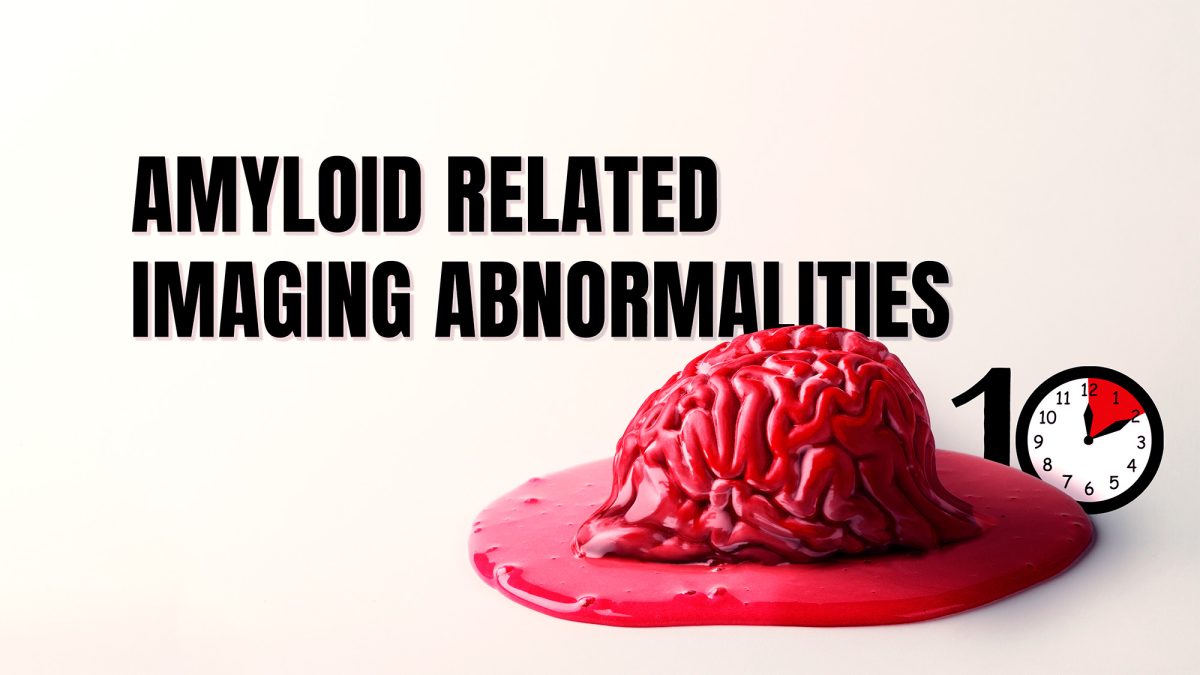Morgenstern, J. Amyloid-related imaging abnormalities: an emergency medicine nightmare?, First10EM,
September 22, 2025. Available at:
https://doi.org/10.51684/FIRS.143660
If you had asked me 5 years ago whether a disease modifying agent for Alzheimer’s disease would be developed, I would have laughed. “Moonshot; million to one; when pigs can fly”. Seems like I am as good at predicting the future as I am at hitting a golf ball. Although there is some debate about their true benefit, such therapies now exist, in the form of anti-amyloid monoclonal antibodies. If you had then asked me whether such a miraculous therapy would make emergency medicine easier or harder, I would have enthusiastically answered “easier”. It has to be easier, right? Dementia patients are among the most difficult to care for, so any disease modifying agent would be a godsend. Perhaps, with time, that will turn out to be true. Unfortunately, right now, I am hearing a lot about adverse events from these medications which are vague, serious, and can only be diagnosed on MRI. That sounds like a potential nightmare, and so we had better try to learn everything we can about amyloid-related imaging abnormalities (ARIA).
As with any topic, once I start down a rabbit hole, I read far too much. There will be a longer list of references at the end. However, most of the information here comes from one excellent article in the Annals of Emergency Medicine, so if you want a more indepth review, I would strongly recommend reading:
Rech MA, Carpenter CR, Aggarwal NT, Hwang U. Anti-Amyloid Therapies for Alzheimer’s Disease and Amyloid-Related Imaging Abnormalities: Implications for the Emergency Medicine Clinician. Ann Emerg Med. 2025 Jun;85(6):526-536. doi: 10.1016/j.annemergmed.2024.12.002. Epub 2025 Jan 17. PMID: 39818674
Amyloid-related imaging abnormalities (ARIA) are a set of potentially serious complications seen on MRI in patients receiving anti-amyloid therapies for Alzheimer’s disease. These complications are mostly asymptomatic, but can occasionally cause significant morbidity. At the time that I am writing this article (summer 2025), there is still a ton that we don’t know about all aspects of this problem, so expect the information below to change over time. If there are significant changes, I will attempt to update this post.
What are these medications? How do they work?
As of 2025, there are two medications on the market: lecanemab (Leqembi) and donanemab (Kisunla). Neither of these agents is currently available in Canada, but both are currently under review by Health Canada. A third agent (aducanumab) was actually the first approved, but has subsequently been voluntarily withdrawn from the market. There are a number of other agents at various stages of research (ponezumab, solanezumab, bapineuzumab, crenezumab, and gantenerumab, at least.)
These are anti-amyloid monoclonal antibodies, thought to potentially modify the course of Alzheimer’s disease by clearing beta-amyloid plaques from the brain. (One of the controversies around these agents has been whether the surrogate outcome of plaque clearing should be used for approval, or whether we (obviously) need more robust clinical evidence of benefit.) They are given as biweekly or monthly infusions, so even if you remember to look for them on a patient’s medication list, there is a chance they won’t be listed with a patient’s daily medications. (And, of course, dementia patients aren’t always able to reliably relate the medications they are on, so one diagnostic hurdle in the emergency department will simply be identifying which patients are actually on these novel agents.)
A brief summary of the evidence
Given that emergency physicians will not be prescribing these agents, I have not performed a deep dive into the evidence, but I think it is worth knowing that there is debate over whether these are providing clinically important benefit. Some clinical trials show modest slowing of cognitive decline. Lecanemab reduced progression of cognitive decline by 27% over 18 months in the CLARITY-AD trial. However, the benefit was not at a threshold that most people would consider clinically important. (This is sort of like a pain trial showing a benefit of 0.7/10. The difference might be real, but it is so small the patient won’t necessarily be able to appreciate the difference.) The big donanemab study – TRAILBLAZER-ALZ 2 – also showed decreased disease progression, using a different scale, but was at a level that might be clinically important.
This moderate clinical benefit has to be weighed against the topic of today’s post: a clear adverse event in these trials in the form of amyloid-related imaging abnormalities. ARIA are very common, occurring in 20-40% of patients, but the vast majority are asymptomatic, and therefore of questionable clinical significance. However, this imagining finding represents cerebral edema and or hemorrhage, which can occasionally result in serious morbidity or even death.
What are amyloid-related imaging abnormalities?
Amyloid-related imaging abnormalities are divided into 2 major categories:
- ARIA-E refers to cerebral edema, and is associated with vasogenic edema or sulcal effusion. About 25% of the edema subtype have symptoms.
- ARIA-H refers to cerebral microhaemorrhages, and is associated with hemosiderin deposition on MRI. These are less likely to be symptomatic unless there is also co-existing edema. However, larger hemorrhages have also been reported.

From Filippi 2022
How do amyloid-related imaging abnormalities present?
The vast majority of patients are asymptomatic. (This is an imaging only finding.) Most occur in the first 6 months of treatment. However, a minority of patients do become symptomatic, with a combination of vague signs and symptoms, including dizziness, headache, confusion, lethargy, gait disturbances, and seizures. Given how common all these symptoms are in the geriatric dementia population, and the fact that most patients with amyloid-related imaging abnormalities are asymptomatic, it is almost impossible to know whether these symptoms are actually caused by the anti-amyloid antibody in any individual patient.
What is the prognosis?
The clinical course of symptomatic ARIA is typically self-limited, resolving over weeks to months, especially with treatment suspension. However, as might be expected from cerebral edema and hemorrhage, there have been significant reported adverse events, including 2 deaths. One was in a 79 year old who developed cerebral arteritis after the third infusion of lecanemab, developed seizures, and ultimately died. Another patient was 65 years old with mild dementia, presented with an acute stroke, was given alteplase, and developed extensive multifocal intraparenchymal hemorrhages.
How might this impact emergency practice?
Although there is a massive amount that we don’t know, and these agents are not widely used (or even available in many jurisdictions), it is probably a good idea to start thinking about how to address these agents. On paper, this complication seems like it is going to be an absolute nightmare for emergency physicians. It requires us to first recognize that patients are on these medications, but these are irregular infusions that might be missed on a medication list, and dementia patients might not be able to reliably list their medications. Second, we have to identify a syndrome with incredibly vague and common symptoms, such as lethargy, confusion, and headaches, in a population that commonly presents with such complaints, and in whom both history and physical exam can be difficult. Next, the diagnosis can only be made on MRI, which is basically impossible to obtain in most emergency departments. Finally, even if you get an MRI, you have to be cognizant of the fact that most of the MRI findings are asymptomatic, and so the imaging abnormalities might not actually be the cause of your patient’s symptoms.
I think we need to make it very clear that the standard of care in emergency medicine is going to be to miss this diagnosis the majority of the time. It will be impossible to practice good medicine otherwise.
Perhaps in the long run we will find out that this is much to do about nothing. That these MRI findings don’t really have important clinical importance, or that we should just guide treatment decisions on symptoms rather than MRI findings.
For now, there are three major areas where you will have to keep these agents in mind.
First is the incredibly common geriatric delirium, or weak and dizzy, or lethargy workup. Check the medication list carefully, and consider whether the patient needs to be admitted for an MRI. If the symptoms are bad enough to warrant admission, it shouldn’t be on us to arrange the imaging, but adding this to your differential and suggesting MRI to the admitting team will probably help. The more difficult patients are those with minor symptoms. Depending on your system, you could either arrange an outpatient MRI, or just ask the patient to talk to the prescribing doctor and hold their infusions until an MRI can be arranged.
Second is the dementia patient with a new indication for anticoagulation, such as atrial fibrillation or pulmonary embolism. One patient in the CLARITY trial was taking apixiban for atrial fibrillation and had an intracranial hemorrhage. That is not a lot of data to go on. Check the medication list carefully and, for now, it seems like we probably need to admit patients to have an MRI done before their anticoagulation is started. (In the trials, there does not seem to be a significant bleed rate with antiplatelet agents, so I think they can still be prescribed, although I haven’t seen any data on dual antiplatelet such as after high risk TIA.)
Finally, the stroke patient who is a candidate for thrombolysis. In the Annals of Emergency Medicine paper, they “strongly recommend MRI prior to administration of thrombolytic in AIS or avoidance of thrombolytics”. (Rech 2025) Practically speaking, that sounds impossible to me, but I guess is a problem for stroke teams, and not for me in my community emergency department. (People have been talking about this specific issue a lot, but I am not sure how common this will be. In my area of the world, dementia and poor baseline function is probably a contraindication of thrombolytics.)
References
Doran SJ, Sawyer RP. Risk factors in developing amyloid related imaging abnormalities (ARIA) and clinical implications. Front Neurosci. 2024 Jan 19;18:1326784. doi: 10.3389/fnins.2024.1326784. PMID: 38312931
Filippi M, Cecchetti G, Spinelli EG, Vezzulli P, Falini A, Agosta F. Amyloid-Related Imaging Abnormalities and β-Amyloid-Targeting Antibodies: A Systematic Review. JAMA Neurol. 2022 Mar 1;79(3):291-304. doi: 10.1001/jamaneurol.2021.5205. PMID: 35099507
Rech MA, Carpenter CR, Aggarwal NT, Hwang U. Anti-Amyloid Therapies for Alzheimer’s Disease and Amyloid-Related Imaging Abnormalities: Implications for the Emergency Medicine Clinician. Ann Emerg Med. 2025 Jun;85(6):526-536. doi: 10.1016/j.annemergmed.2024.12.002. Epub 2025 Jan 17. PMID: 39818674
Greenberg SM, Bax F, van Veluw SJ. Amyloid-related imaging abnormalities: manifestations, metrics and mechanisms. Nat Rev Neurol. 2025 Apr;21(4):193-203. doi: 10.1038/s41582-024-01053-8. Epub 2025 Jan 10. PMID: 39794509
Salloway S, Chalkias S, Barkhof F, Burkett P, Barakos J, Purcell D, Suhy J, Forrestal F, Tian Y, Umans K, Wang G, Singhal P, Budd Haeberlein S, Smirnakis K. Amyloid-Related Imaging Abnormalities in 2 Phase 3 Studies Evaluating Aducanumab in Patients With Early Alzheimer Disease. JAMA Neurol. 2022 Jan 1;79(1):13-21. doi: 10.1001/jamaneurol.2021.4161. PMID: 34807243
Sims JR, Zimmer JA, Evans CD, Lu M, Ardayfio P, Sparks J, Wessels AM, Shcherbinin S, Wang H, Monkul Nery ES, Collins EC, Solomon P, Salloway S, Apostolova LG, Hansson O, Ritchie C, Brooks DA, Mintun M, Skovronsky DM; TRAILBLAZER-ALZ 2 Investigators. Donanemab in Early Symptomatic Alzheimer Disease: The TRAILBLAZER-ALZ 2 Randomized Clinical Trial. JAMA. 2023 Aug 8;330(6):512-527. doi: 10.1001/jama.2023.13239. PMID: 37459141
Sperling R, Salloway S, Brooks DJ, Tampieri D, Barakos J, Fox NC, Raskind M, Sabbagh M, Honig LS, Porsteinsson AP, Lieberburg I, Arrighi HM, Morris KA, Lu Y, Liu E, Gregg KM, Brashear HR, Kinney GG, Black R, Grundman M. Amyloid-related imaging abnormalities in patients with Alzheimer’s disease treated with bapineuzumab: a retrospective analysis. Lancet Neurol. 2012 Mar;11(3):241-9. doi: 10.1016/S1474-4422(12)70015-7. Epub 2012 Feb 3. PMID: 22305802
van Dyck CH, Swanson CJ, Aisen P, Bateman RJ, Chen C, Gee M, Kanekiyo M, Li D, Reyderman L, Cohen S, Froelich L, Katayama S, Sabbagh M, Vellas B, Watson D, Dhadda S, Irizarry M, Kramer LD, Iwatsubo T. Lecanemab in Early Alzheimer’s Disease. N Engl J Med. 2023 Jan 5;388(1):9-21. doi: 10.1056/NEJMoa2212948. Epub 2022 Nov 29. PMID: 36449413










